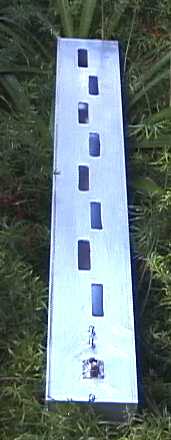
- 10 Ghz Waveguide Slot Antenna Tuner
- 10 Ghz Waveguide Slot Antenna Combo
- 10 Ghz Waveguide Slot Antenna Receiver
- 10 Ghz Waveguide Slot Antenna Booster
Additionally, dual-band dual-polarization waveguide slots antenna at 30 and 35 GHz is proposed in 10. The narrow wall is implemented with 9×10 inclined slots array at 35 GHz to form horizontal polarization, and 8×10 longitude slots array is distributed on the broad wall at 30 GHz to form vertical polarization. Abstract: A dual-layer multibeam conformal slot array antenna operating at a center frequency of 10 GHz is proposed in this paper. The antenna consists of a microstrip Rotman lens and a substrate-integrated waveguide (SIW) array of 10×10 radiating slots, which is axially mounted onto a cylindrical surface with a radius of 90 mm, i.e., 3λ 0. This antenna operates in TE 10 mode of excitation of the SIW at resonant frequency of 9.73 GHz. Rogers RT/Duroid 5880 is used as a dielectric substrate having permittivity 2.2 and thickness 1.575 mm. A 50 ohm conventional microstrip feedline is used to perfectly match the SIW slot antenna. The slot dimension is kept. With a 16-slot total, the antenna can have 10-12 dBi gain. Slot antennas can be built from surplus waveguide sections, which will give an omni-directional pattern and horizontal polarization. This paper offers a computer aided method to calculate the proper dimensions for the slots and their locations. Waveguide Slot Antenna Calculator. Frequency, 10.368, GHz. Cubical Quad Antenna Calculator The gain of an an antenna with parasitic elements varies with the spacing and tuning of the elements, and thus for any given spacing there is a tuning condition that will give maximum gain this spacing.
10 GHz Omnidirectional Antenna
Ken Vickers G3YKI
There is no shortage of information on how to design slotted waveguide antennas, but to actually make them can become a problem without relatively sophisticated machining facilities, especially when you get to the higher frequencies. For example, the slots in an X band antenna might be about 1mm wide by 12 mm long and difficult to make by hand. This antenna was made in a few hours and requires no more than a hand drill, saw and file.
So what's the difference?

This antenna uses round holes rather than slots. They are much easier to make! A normal slotted waveguide antenna has the slots in the broad face of the waveguide. The broad face (of a vertical waveguide) has both vertical and horizontal currents, so a vertical slot has to be used if you want to radiate only horizontal polarisation. The short face carries only horizontal currents so the shape of the holes does not matter much.
I searched all the antenna books I could find, but no one mentioned an antenna like this. But after I convinced myself that it should work, I made one, and it did work.

What are the Disadvantages?

The holes are not resonant at 10 GHz, so they do not radiate as readily as resonant slots. The result is a high 'Q' sharply tuned antenna.
The radiating elements on opposite sides of the waveguide are further apart, so the omnidirectionality is not as good.
The vertical spacing of the elements is greater than one wavelength in free space which leads to less than optimum gain for the length of the antenna, and larger sidelobes in the vertical plane.
How to make it.
Dimensions relate to WG16 for 10.368 GHz.
The waveguide must be exactly a multiple of one half guide wavelength long between short circuits at the operating frequency. The holes are 3/8' (9.5mm) diameter (largest possible)and spaced one guide wavelength apart, starting one quarter guide wavelength from the short circuit. Holes at the same height on opposite faces will give opposite contributions in the directions of the broad face, resulting in a null in that direction. To get the side lobes, as in the pattern shown, the holes on opposite faces are offset by one half wavelength vertically.
A tuning screw is required to set the resonant frequency. The antenna is fed at the centre by a small probe in the centre of the broad face, rather like any other co-axial to waveguide transition.
Results
The antenna was set up on a tripod with receiver and the vertical and horizontal radiation patterns were measured.Vertical and horizontal Radiation Patterns of a 6 Element Antenna.
10 Ghz Waveguide Slot Antenna Tuner
Polarisation
The antenna was also measured with a vertically polarised source to confirm that it really was working as a horizontally polarised antenna. The response was generally about 20 dB down on the horizontal response. Considering that my 'test range' was surrounded by trees, some of which would be illuminated with RF and scatter it with random polarisation, I would not expect any better.
10 Ghz Waveguide Slot Antenna Combo
More Pictures Let me know if you found this interesting,especially if you build one!